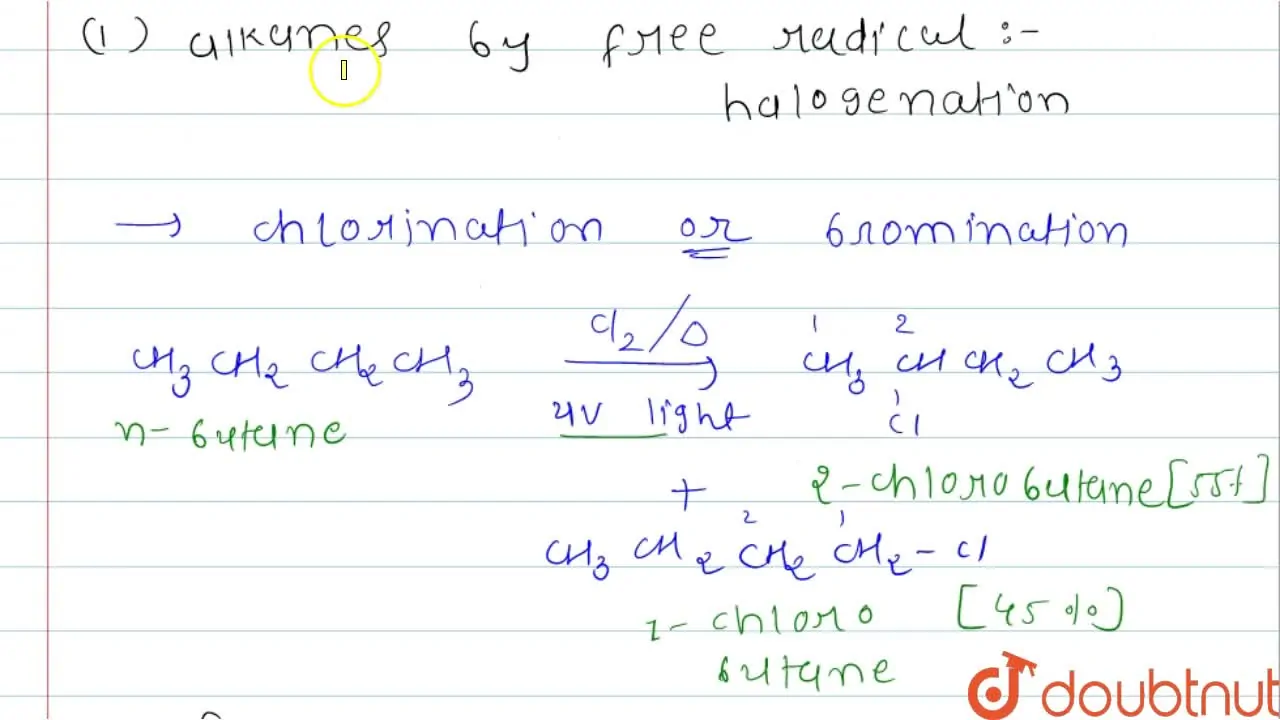Give preparation of haloalkanes from hydrocarbons. Solution in Gujrati
(i) From alkanes by free radical halogenation : Free radical chlorination or bromination of alkanes gives a complex mixture of isomeric mono - and polyhaloalkanes, which is difficult to separate as pure compounds. Consequently, the yield of any single compound is low.
CH3CH2CH2CH3Cl2/Δ−−−−−−−→ or UV light CH3CHClCH2CH32-Chlorobutane (55%)+CH3CH2CH2CH2Cl1-Chlorobutane (45%)
(ii) From alkenes : Alkyl halides can be prepared from alkenes by addition of hydrogen acids such as HCl, HBr and HI.
H2CEthene=CH2+HI→CH3CH2IIodoethane
In case of unsymmetrical alkenes, the addition takes place by Markovnikov.s rule.
CH3CH=CH2Prop-1-ene+HI−−→CH3CHICH32-iodopropane(major)+CH3CH2CH2I1-iodopropane(minor)
However, if the peroxide (R2O2) is present, the reaction takes place contrary to Markovanikov.s rule. This is known as Kharasch effect.
CH3−CH=CH2+HBrProp-1-ene(C6H5CO)2O2−−−−−−−−−→CH3CH2CH2Br1-Bromopropane
In the laboratory, addition of bromine in CCl4 to an alkene resulting in discharge of reddish brown colour of bromine constitutes an important method for detection of double bonds in a molecule. The addition results in the synthesis of (vic -dibromides which are colourless) vicinal dihalides.
H2CEthene=CH2+Br2CCl4−−→CH2| Br −CH2| Br 1,2-dibromoethane
Related Playlists
- BOOK - KUMAR PRAKASHANCHAPTER - HALOALKANES AND HALOARENESEXERCISE - SECTION - B INTEXT QUESTIONS AND ANSWERS20videos
HALOALKANES AND HALOARENES
- BOOK - KUMAR PRAKASHANCHAPTER - HALOALKANES AND HALOARENESEXERCISE - SECTION - C TEXTUAL EXERCISE87videos
HALOALKANES AND HALOARENES
- BOOK - KUMAR PRAKASHANCHAPTER - HALOALKANES AND HALOARENESEXERCISE - SECTION - E Multiple Choice Questions260videos
HALOALKANES AND HALOARENES
- BOOK - KUMAR PRAKASHANCHAPTER - GENERAL PRINCIPLES AND PROCESSES OF ISOLATION OF ELEMENTSEXERCISE - SECTION - E (MCQs ASKED IN GUJET/BOARD EXAMS)46videos
GENERAL PRINCIPLES AND PROCESSES OF ISOLATION OF ELEMENTS
- BOOK - KUMAR PRAKASHANCHAPTER - POLYMERSEXERCISE - SECTION - E (MCQs asked in Board Exams)51videos
POLYMERS
Similar Questions
Write the structures of the following compounds :
2-Chloro-3-methylentaneView SolutionName the following halides according to IUPAC system and classify them as alkyl, allyl, benzyl (primary, secondary, tertiary), vinyl or aryl halides :
(CH3)2CHCH(Cl)CH3View SolutionThe derivatives that are not found in nature are …..
46:27View SolutionDuring electrolysis of aqueous solution of Na2SO4 using graphite electrode .........
43:14View SolutionWhich polymer is used in preparation of capsules ?
04:12View SolutionIn the preparation of Grignard reagent from haloalkane, the metal used is
View SolutionHow will you prepare haloalkane from alcohol and hydrocarbon ? Write one chemical reaction of each.
View SolutionHaloalkanes and Haloarens|Preparation Of HaloAlkanes 1 - From Alkanes and Alkene
02:12View SolutionHaloAlkanes and HaloArenes 02|Preparation Of HaloAlkanes 2 - From Alkanes and Alkene
04:17View SolutionGive preparation of aryl halides from aromatic hydrocarbons.
01:05View SolutionGive the preparation of alkane from the unsaturated hydrocarbons.
01:22View SolutionIn the preparation of Grignard reagent from haloalkane, the metal used is
01:21:54View SolutionDiscuss preparation of haloalkane from alkene.
35:54View SolutionDiscuss preparation of haloalkanes from alcohols.
03:11View SolutionHaloalkanes and haloarenes react with metals to give hydrocarbons from which hydrocarbons are obtained easily.Identify the product
 04:22View Solution
04:22View Solution


